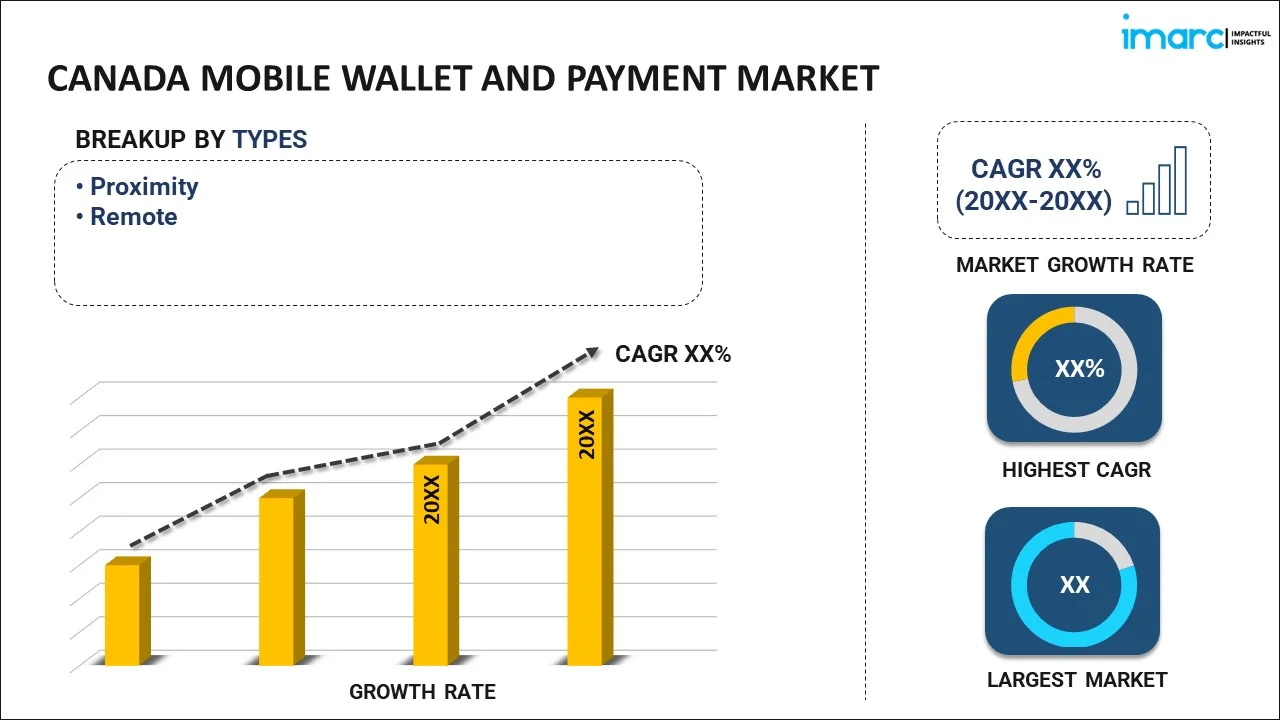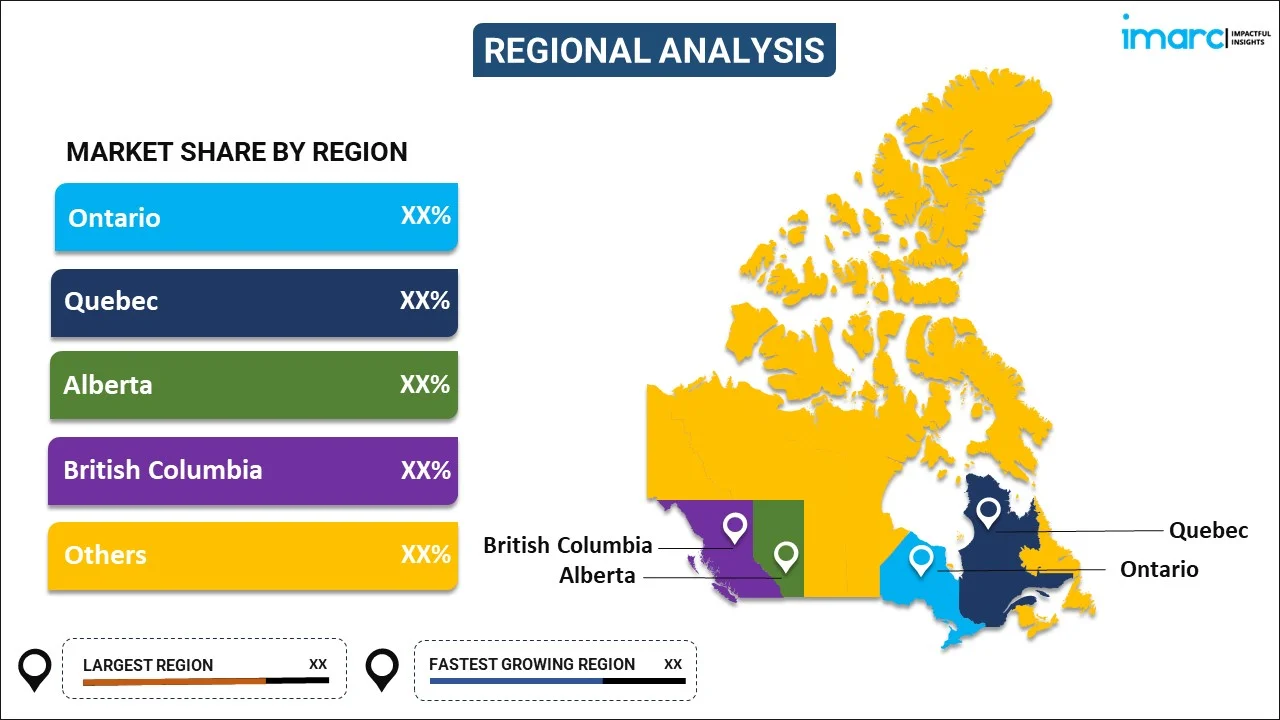
Canada Mobile Wallet and Payment Market Report by Type (Proximity, Remote), Application (Retail, Hospitality and Transportation, Telecommunication, Healthcare, and Others), and Region 2025-2033
Canada Mobile Wallet and Payment Market Overview:
The Canada mobile wallet and payment market size reached USD 57.5 Billion in 2024. Looking forward, IMARC Group expects the market to reach USD 146.3 Billion by 2033, exhibiting a growth rate (CAGR) of 10.93% during 2025-2033. The heightened use of smartphone to pay for services and products, increasing adoption of advanced technologies to improve the functionalities of payment applications, and rising implementation of supportive regulatory policies in the financial ecosystem are some of the crucial factors impelling the Canada mobile wallet and payment market share.
|
Report Attribute
|
Key Statistics
|
|---|---|
|
Base Year
|
2024
|
|
Forecast Years
|
2025-2033
|
|
Historical Years
|
2019-2024
|
|
Market Size in 2024
|
USD 57.5 Billion |
|
Market Forecast in 2033
|
USD 146.3 Billion |
| Market Growth Rate 2025-2033 | 10.93% |
Canada Mobile Wallet and Payment Market Analysis:
- Major Drivers: Growing smartphone use, increasing digital literacy, supportive regulations, and demand for convenient, contactless payment methods drive mobile wallet adoption across consumers, businesses, and financial institutions in Canada.
- Key Market Trends: Consumers increasingly prefer digital wallets over cash or cards, with growth in contactless, peer-to-peer, and in-app payments. Retailers and service providers are integrating mobile payment options across platforms.
- Market Challenges: some of the key constraints in the Canada mobile wallet and payment market analysis are the security concerns, fragmented infrastructure, slow adoption by smaller merchants, legacy systems, and lack of interoperability between platforms create friction in scaling mobile wallet solutions across Canada’s diverse population.
- Market Opportunities: Expansion into underserved regions, open banking frameworks, innovation in payment technologies, partnerships between fintechs and banks, and rising interest in real-time payments present avenues for future market growth.
Canada Mobile Wallet and Payment Market Trends:
Technological Advancements and Adoption of Smartphones
The swift advancement and extensive integration of smartphones have had a notable impact on the expansion of the mobile wallet and payment industry in Canada. Advanced smartphone features like Near Field Communication (NFC) have increased the security and accessibility of contactless payments. This technology improves transaction speed and ease by enabling consumers to pay with a simple tap of their devices on point-of-sale terminals.
In addition, the widespread availability of mobile data services and high-speed internet is making seamless connectivity possible, allowing users to conduct financial transactions from any location at any time. Beyond simple payment processing, mobile wallets now facilitate peer-to-peer money transfers, bill payments, and online shopping. Customers are now using mobile wallets more frequently for everyday financial transactions as a result of these enhanced features.
The incorporation of biometric verification techniques, such as facial recognition and fingerprint authentication, is also increasing customer trust in the safety of mobile payments. By preventing fraud and unwanted access, these measures make sure that mobile transactions are just as safe as traditional payment methods, if not safer. It is anticipated that as technology develops, new discoveries will improve the security and usability of mobile wallets, increasing their popularity.
Shifts in User Behavior and Preferences
Another significant Canada mobile wallet and payment market trends is the shifting user tastes and behaviour. Modern users want their financial transactions to be quick, easy, and efficient-things that mobile wallets easily deliver. Because they are more tech-savvy and drawn to digital solutions, younger populations are where this transition is most apparent.
Additionally, the use of mobile wallets has increased due to the rising popularity of online shopping. Mobile payment alternatives are frequently implemented into online shopping platforms, which improves the entire buying experience by expediting the checkout process. Mobile wallet loyalty programs and prizes that allow users to accrue points, cash back, or discounts with every purchase further encourage its use.
Supportive Regulatory Environment and Financial Ecosystem
A strong financial ecosystem and a kind regulatory framework have been instrumental in the Canada mobile wallet and payment market growth and payment business. Canadian authorities have built regulatory frameworks that guarantee mobile payment systems meet strict security and privacy standards, thereby cultivating consumer confidence.
Policies that support the secure and effective functioning of digital payment systems have been put in place by the Canadian government and regulatory organizations, including the Financial Consumer Agency of Canada (FCAC) and the Office of the Superintendent of Financial Institutions (OSFI). By addressing concerns about fraud prevention, data protection, and consumer rights, these regulations establish a safe environment for transactions involving mobile wallets.
Furthermore, the establishment of a unified ecosystem for mobile payments has been made possible by cooperation between financial institutions, payment networks, and technology suppliers. Mobile wallet services have been included by banks and credit unions into their products, giving clients easy access to digital payment choices.
Canada Mobile Wallet and Payment Market Segmentation:
IMARC Group provides an analysis of the key trends in each segment of the market, along with forecasts at the country level for 2025-2033. Our report has categorized the market based on type and application.
Type Insights:

To get more information on this market, Request Sample
- Proximity
- Remote
The report has provided a detailed breakup and analysis of the market based on the type. This includes proximity and remote.
Application Insights:
- Retail
- Hospitality and Transportation
- Telecommunication
- Healthcare
- Others
A detailed breakup and analysis of the market based on the application have also been provided in the report. This includes retail, hospitality and transportation, telecommunication, healthcare, and others.
Regional Insights:

- Ontario
- Quebec
- Alberta
- British Columbia
- Others
The report has also provided a comprehensive analysis of all the major regional markets, which include Ontario, Quebec, Alberta, British Columbia, and Others.
Competitive Landscape:
The market research report has also provided a comprehensive analysis of the competitive landscape. Competitive analysis such as market structure, key player positioning, top winning strategies, competitive dashboard, and company evaluation quadrant has been covered in the report. Also, detailed profiles of all major companies have been provided.
Canada Mobile Wallet and Payment Market News:
- In May 2025, Toronto-based fintech Dream Payments added Interac e-Transfer to its DreamPay platform, enabling real-time payouts across Canada. Businesses, insurers, and platforms can now send funds using just an email or phone number—no banking details required. The service joins existing EFT, virtual card, and cheque options. DreamPay integrates seamlessly with ERP, treasury, and claims systems, offering fast, secure disbursements without infrastructure changes.
- May 2024: Visa unveiled new products and services that aim to revolutionize the card and address the upcoming needs of companies, merchants, and users along with the financial institutions serving them.
- In November 2024, Canadian startup Beacon introduced a digital wallet tailored for immigrants, allowing users to open and fund accounts before arriving in Canada—no SIN, local ID, or address required. The wallet supports salary deposits, bill payments, and includes a prepaid Visa card. A global funding option via SWIFT and a dedicated India-focused remit tool are offered. Public launch is set for January, following a C$5.25M seed round.
- August 2023: BMO Commercial Bank launched mobile wallet for virtual cards with MasterCard and Extend four US and Canada users. The app presents new functionality that will provide cardholders the power to present and push virtual cards to their employees’ mobile wallets.
Canada Mobile Wallet and Payment Market Report Coverage:
| Report Features | Details |
|---|---|
| Base Year of the Analysis | 2024 |
| Historical Period | 2019-2024 |
| Forecast Period | 2025-2033 |
| Units | Billion USD |
| Scope of the Report | Exploration of Historical Trends and Market Outlook, Industry Catalysts and Challenges, Segment-Wise Historical and Future Market Assessment:
|
| Types Covered | Proximity, Remote |
| Applications Covered | Retail, Hospitality and Transportation, Telecommunication, Healthcare, Others |
| Regions Covered | Ontario, Quebec, Alberta, British Columbia, Others |
| Customization Scope | 10% Free Customization |
| Post-Sale Analyst Support | 10-12 Weeks |
| Delivery Format | PDF and Excel through Email (We can also provide the editable version of the report in PPT/Word format on special request) |
Key Benefits for Stakeholders:
- IMARC’s industry report offers a comprehensive quantitative analysis of various market segments, historical and current market trends, market forecasts, and dynamics of the Canada mobile wallet and payment market from 2019-2033.
- The research report provides the latest information on the market drivers, challenges, and opportunities in the Canada mobile wallet and payment market.
- Porter's five forces analysis assist stakeholders in assessing the impact of new entrants, competitive rivalry, supplier power, buyer power, and the threat of substitution. It helps stakeholders to analyze the level of competition within the Canada mobile wallet and payment industry and its attractiveness.
- Competitive landscape allows stakeholders to understand their competitive environment and provides an insight into the current positions of key players in the market.
Key Questions Answered in This Report
The mobile wallet and payment market in Canada was valued at USD 57.5 Billion in 2024.
The Canada mobile wallet and payment market is projected to exhibit a CAGR of 10.93% during 2025-2033, reaching a value of USD 146.3 Billion by 2033.
Key factors driving Canada’s mobile wallet and payment market include widespread smartphone usage, growing demand for contactless payments, supportive regulatory frameworks, fintech innovation, and increased digital banking adoption. Consumers seek convenience and security, while businesses embrace faster, more efficient transactions. Open banking and real-time payment systems further accelerate market growth.
Need more help?
- Speak to our experienced analysts for insights on the current market scenarios.
- Include additional segments and countries to customize the report as per your requirement.
- Gain an unparalleled competitive advantage in your domain by understanding how to utilize the report and positively impacting your operations and revenue.
- For further assistance, please connect with our analysts.
 Request Customization
Request Customization
 Speak to an Analyst
Speak to an Analyst
 Request Brochure
Request Brochure
 Inquire Before Buying
Inquire Before Buying




.webp)




.webp)












